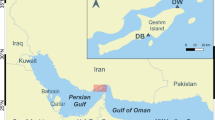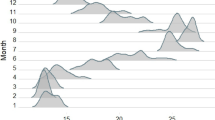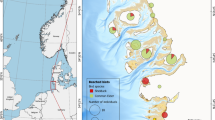Abstract
The diet of 50 juvenile green turtles Chelonia mydas live-captured incidentally by fixed fishing traps between January and June 2009 in Cananéia Estuarine–Lagoon complex, Brazil, was studied through analysis of esophageal lavage samples. Green turtles consumed an omnivorous diet, with 18 food components identified and grouped into 4 categories as follows: terrestrial plants, algae, invertebrates, and seagrass. Black mangrove leaves were of the greatest importance to diet. Turtles incidentally get into fixed traps probably because these devices are located on mangrove margins, where they forage. The additional foods suggest that green turtles also feed opportunistically on material adhered to the trap structure and/or on items that cross into its interior. Green turtle diet in estuarine environments appears to be determined by the availability of food components, with some selectivity toward items of apparently greater nutritional value.





Similar content being viewed by others
References
Amorocho DF, Reina RD (2007) Feeding ecology of the East Pacific green sea turtle Chelonia mydas agassizii at Gorgona National Park, Colombia. Endanger Species Res 3:43–51
André J, Gyuris E, Lawler IR (2005) Comparison of the diets of sympatric dugongs and green turtles on the Orman Reefs, Torres Strait. Wildl Res 32:53–62
Arthur KE, McMahon KM, Limpus CJ, Dennison WC (2009) Feeding ecology of green turtles (Chelonia mydas) from Shoalwater Bay, Australia. Mar Turt Newsl 123:6–12
Balazs GH (1982) Growth rates of immature green turtles in the Hawaiian archipelago. In: Bjorndal KA (ed) Biology and conservation of sea turtles. Smithsonian Institution Press, Washington, pp 117–125
Bérgamo AL (2000) Características da hidrografia, circulação e transporte de sal: Barra de Cananéia, sul do Mar de Cananéia e Baía do Trapandé. MS dissertation. Universidade de São Paulo, São Paulo
Bjorndal KA (1982) The consequences of herbivory for the life history pattern of the Caribbean green turtle, Chelonia mydas. In: Bjorndal KA (ed) Biology and conservation of sea turtles. Smithsonian Institution Press, Washington, pp 111–116
Bjorndal KA (1985) Nutritional ecology of sea turtles. Copeia 3:736–751
Bjorndal KA (1997) Foraging ecology and nutrition of sea turtles. In: Lutz P, Musick J (eds) The biology of sea turtles. CRC Press, Boca Raton, pp 199–232
Bjorndal KA, Suganuma H, Bolten AB (1991) Digestive fermentation in green turtles, Chelonia mydas, feeding on algae. Bull Mar Sci 48(1):166–171
Bondioli ACV (2009) Estrutura populacional e variabilidade genética de tartaruga verde (Chelonia mydas) da região de Cananéia, São Paulo. PhD thesis, Universidade de São Paulo, São Paulo
Bondioli ACV, Nagaoka SM, Monteiro-Filho ELA (2008) Chelonia mydas Habitat and occurrence. Herpetol Rev 39(2):213
Brand–Gardner S, Lanyon J, Limpus C (1999) Diet selection of immature green turtles, Chelonia mydas, in subtropical Moreton Bay, Southeast Queensland. Aust J Zool 47:181–191
Bugoni L, Krause L, Petry MV (2003) Diet of sea turtles in Southern Brazil. Chelonian Conserv Biol 4(3):685–688
Cardona L, Aguilar A, Pazos L (2009) Delayed ontogenic dietary shift and high levels of omnivory in green turtles (Chelonia mydas) from the NW coast of Africa. Mar Biol 156:1487–1495
Carrión-Cortez JAC, Zárate P, Seminoff JA (2010) Feeding ecology of the green sea turtle (Chelonia mydas) in the Galapagos Island. J Mar Biol Assoc UK 1–9
Diegues AC (1987) Conservação e desenvolvimento sustentado de ecossistemas litorâneos no Brasil. Secretaria Estadual do Meio Ambiente de São Paulo, São Paulo
Epperly SP, Braun J, Veishlow A (1995) Sea turtles in North Carolina waters. Conserv Biol 9:384–394
Epperly SP, Braun-McNeill J, Richards PM (2007) Trends in catch rates of sea turtles in North Carolina, USA. Endanger Species Res 3:283–293
FAO (2010) Fishing gear types. Traps. In: FAO fisheries and aquaculture department, Rome. Accessed 20 Feb. www.fao.org/fishery/geartype
Ferreira MM (1968) Sobre a alimentação da Aruanã, Chelonia mydas (Linnaeus), ao longo da costa do Estado do Ceará. Arquivos da Estação de Biologia Marinha da Universidade Federal do Ceará. Fortaleza 8(1):83–86
Forbes GA (1999) Diet sampling and diet component analysis. In: Eckert KL, Bjorndal KA, Abreu-Grobois FA, Donnelly M (eds) Research and management techniques for the conservation of sea turtles. IUCN/SSC Marine Turtle Specialist Group Publication N° 4, Pennsylvania, pp 144–151
Forbes GA, Limpus CJ (1993) A non-lethal method for retrieving stomach contents from sea turtles. Wildl Res 20:339–343
Fuentes MMPB, Lawler IR, Gyuris E (2006) Dietary preferences of juvenile green turtles (Chelonia mydas) on a tropical reef flat. Wildl Res 33:671–678
Garnett ST, Price IR, Scott FJ (1985) The diet of the green turtle. Chelonia mydas (Linnaeus.) in Torres Strait. Aust Wildl Res 12:103–112
Godley TJ, Thompson DR, Waldron S, Furness RW (1998) The trophic status of marine turtles as determined by stable isotope analysis. Mar Ecol Prog Ser 166:277–284
Guebert FM (2008) Ecologia Alimentar e consumo de material inorgânico por tartarugas verdes, Chelonia mydas, no litoral do Estado do Paraná. MS dissertation. Universidade Federal do Paraná, Curitiba
Hatase H, Sato K, Yamaguchi M, Takahashi K, Tsukamoto K (2006) Individual variation in feeding habitat use by adult female green sea turtles (Chelonia mydas): are they obligately neritic herbivores? Oecologia 149:52–64
Hirth HF (1997) Synopsis of the biological data on the green turtle Chelonia mydas (Linnaeus 1758). US Fish Wildl Serv Biol Rep 97(1) (Washington, DC)
Lima EHSM (1999) Captura acidental de tartarugas marinhas em currais de pesca na praia de Almofala-Itarema/CE: Subsídios para a preservação dos quelônios marinhos em áreas de alimentação. MS dissertation. Universidade Federal do Ceará, Fortaleza
Limpus CJ (1995) Global overview of the status of marine turtles: a 1995 viewpoint. In: Bjorndal KA (ed) Biology and conservation of sea turtles, 2nd edn. Smithsonian Institution Press, Washington, pp 605–610
Limpus CJ, Limpus DJ (2000) Mangrove in the diet of Chelonia mydas in Queensland, Australia. Mar Turt Newsl 89:13–15
Lopez-Mendilaharsu M, Gardner SC, Seminoff JA, Riosmena-Rodriguez R (2005) Identifying critical foraging habitats of the green turtles (Chelonia mydas) along the Pacific coast of the Baja California Peninsula, Mexico. Aquat Conserv Mar Freshw Ecossyst 15:259–269
Lopez-Mendilaharsu M, Gardner SC, Riosmena-Rodriguez RR, Seminoff JA (2008) Diet selection by immature green turtles (Chelonia mydas) at Bahıa Magdalena foraging ground in the Pacific Coast of the Baja California Peninsula, Mexico. J Mar Biol Assoc UK 1–7
Mansfield KL (2006) Sources of mortality, movements and behavior of sea turtles in Virginia. Ph.D Dissertation. College of William and Mary, Virginia
Mendonça JT (1998) A pesca na região de Cananéia—SP—Brasil, nos anos de 1995 e 1996. MS dissertation, Universidade de São Paulo, SP
Mesquita AR, Harari J (1988) Tábuas das marés de Ubatuba e Cananéia para os anos de 1988 e 1989. Relat Int Inst Oceanog Univ São Paulo 24:1–20
Miyao SY, Nishihara L, Sarti CC (1986) Caracteristicas fisico-quimicas do sistema estarino-lagunar de Cananéia- Iguape. Boletim do Instituto Oceanografico USP 34:23–36
Mohan MV, Sankaran TM (1988) Two new indices for stomach content analysis of fishes. J Fish Biol 33:289–292
Moran KL, Bjorndal KA (2005) Simulated green turtle grazing affects structure and productivity of seagrass pastures productivity of seagrass pastures. Mar Ecol Prog Ser 305:235–247
Mortimer J (1981) The feeding ecology of the west caribbean green turtle (Chelonia mydas) in Nicaragua. Biotropica 13(1):49–58
Nagaoka SM, Bondioli ACV, Monteiro-Filho ELA (2008) Sea Turtle Bycatch by Cerco-fixo in Cananéia Lagoon Estuarine Complex, São Paulo, Brazil. Mar Turt Newsl 119:4–6
Oliveira EC (1984) Brazilian mangal vegetation with special emphasis on the seaweeds. In: Por FD, Dor I (eds) Hydrobiology of the Mangal. Dr W. Junk Publishers, The Hague, pp 55–65
Oliveira FC (2007) Etnobotânica da exploração de espécies vegetais para confecção do cerco-fixo na região do Parque Estadual Ilha do Cardoso, SP. MS dissertation, Universidade Federal de Santa Catarina, Florianópolis
Pendoley K, Fitzpatrick J (1999) Browsing on mangroves by green turtles in Western Australia. Mar Turt Newsl 84:10
Pritchard PCH (1971) Galápagos sea turtles–preliminary findings. J Herpetol 5:1–9
Ramos EB, Gallo JE, Verrone VMA (1980) Áreas da região lagunar Cananéia-Iguape susceptíveis da exploração pesqueira segundo diversos tipos de tecnologia, I—Pesca com cerco-fixo. Boletim do Instituto Oceanográfico USP 29(2):329–335
Reich KJ, Bjorndal KA, Bolten AB (2007) The ‘lost years’ of green turtles: using stable isotopes to study cryptic lifestages. Biol Lett (3):712–714
Ross JP (1985) Biology of the green turtle, Chelonia mydas, on an Arabian feeding ground. J Herpetol 19:459–468
Schaeffer-Novelli Y, Mesquita HSL, Cintrón-Molero G (1990) The Cananéia Lagoon Estuarine System. Estuaries 13(2):193–203
Scholander PF (1968) How mangroves desalinate water. Physiol Plant 21:251–261
Seminoff JA, Resendiz A, Nichols WJ (2002) Diet of East Pacific green turtles (Chelonia mydas) in the central Gulf of California, Mexico. J Herpetol 36(3):447–453
Tomlinson PB (1986) The botany of mangroves. Cambridge University Press, Cambridge, p 419
Acknowledgments
We thank the FAPES and CNPq (ASM grant 308867/2006-8) for the financial support. This research was permitted by ICMBio/SISBIO (license 18781-1).
Author information
Authors and Affiliations
Corresponding author
Additional information
Communicated by R. Lewison.
Rights and permissions
About this article
Cite this article
Nagaoka, S.M., Martins, A.S., dos Santos, R.G. et al. Diet of juvenile green turtles (Chelonia mydas) associating with artisanal fishing traps in a subtropical estuary in Brazil. Mar Biol 159, 573–581 (2012). https://doi.org/10.1007/s00227-011-1836-y
Received:
Accepted:
Published:
Issue Date:
DOI: https://doi.org/10.1007/s00227-011-1836-y




